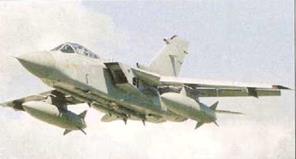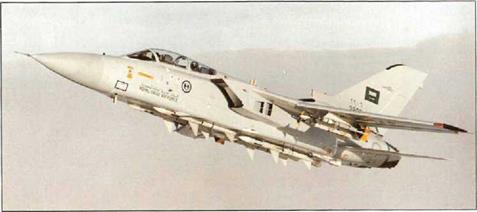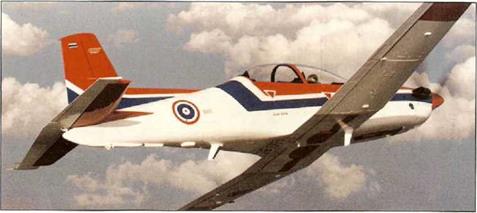UK
Long-range interceptor and air defence aircraft
|
|
D |
eveloped from the Tornado interdictor to meet a unique British requirement, the Tornado ADV (Air Defence Variant) was optimised for iong – rarge, all-weather interception. Its primary mission is the defence of the UK Air Defence Region and UK maritime forces, with an important out-of-area commitment. The ADV was designed around the Marconi AI. Mk 24 Foxhunter radar and an armament of four Sky Flash AAMs. One 27-mm cannon was retained, but the other was removed to make room for a fully-retractable inflight refuelling probe. The radar suffered development problems and delays, before being brought to an acceptable standard by 1990. Carrying the’ primary missile armament semi- recessed under the fuselage necessitated a lengthened airframe and increased internal fuel capacity.
The first of three prototypes flew on 27 October 1979 and these were followed by 18 interim Tornado F. Mk 2s with RB 199 Mk 103 engines. These early aircraft initially flow with lead ballast in place of radar and performed only conversion training duties until January 1988. Plans for their conversion to operational standards as F. Mk 2As were never implemented, and they were scrapped.
The definitive Tornado F. Mk 3 first flew in November 1985. BAe produced 144 aircraft (38
This Tornado F. Mk 3 was a development aircraft for the CSP upgrade and is carrying four AMRAAM missiles, replacing the less capable Sky Flash.
with dual-controls), including a cancelled Omari order for eight aircraft which were transferred to the RAF before completion. Some 24 more were built for Saudi Arabia from 1989, but a second Saudi batch was cancelled. 24 ex-RAF Tornado F. Mk 3s were leased to Italy from 1995 as a stopgap measure, pending the availability of the Eurofighter Typhoon. Their replacement by F-16s was announced in 2001.
The Tornado F. Mk 3 Introduced Mk 104 engines, a second INS, and provision for four AIM-9L Sidewinders (instead of two). Upgrades in service ‘fixed’ the radar problems, added FIOTAS controls, added Flermes RHAWS and other defensive systems improvements A Tornado Capability Sustainment Programme launched in 1996 wil provide a MIL STD 1553B dataous and an enhanced main computer. It will also integrate the AIM-120 AMRAAM and the short range ASRAAM on the Tornado F. Mk 3, and will parcel together a number of other improvements, some of which were already underway, including provision for JTIDS and a towed radar decoy.
Five front-line RAF units operate the Tornado F. Mk 3, and the type has seen extensive operational service in the Middle East and the Balkans.

|
|
Switzerland
Turboprop basic and advanced trainer
|
|
S |
witzerland’s Pilatus PC-7 is derived from the piston-engined P-З, but with a PT6A-25 turboprop, a new wing, bubble canopy and six hardpoints for up to 1040 kg (2,293 lb) of stores,
The first production PC-7 Turbo Trainer made its maiden flight on 18 August 1978. First deliveries were to Burma in 1979. With the Beech T-34C Turbo Mentor then its sole production competitor, the PC-7 achieved growing export success, supplemented (after a two-year evaluation) in June 1981 by a Swiss order for 40.
Over 500 PC-7s have been sold to military customers in 20 countries including are Abu Dhabi, Angola, Austria, Bolivia, Bophuthatswana, Botswana, Burma, Brunei. Chile, France, Guatemala, Iran, Iraq, Malaysia, Mexico, the Netherlands. Nigeria, South Africa, Surinam. Switzerland and Uruguay. PC-7s are believed to have been used operationally by both sides in the Iran/lraq war. In 1985, Pilatus offered an optional installation of twin Martin-Baker СИ Mk 15A lightweight ejection seats.
The prototype Pilatus PC-9 made its first flight on 7 May 1984, was powered by an 857-kW (1,150-hp) P&WC PT6A-62 turboprop. Although derived from the PC-7, there is only 10 per cent structural commonality between the two. The PC-9 is dimension – ally similar, but is distinguished by its larger canopy, ‘stepped’ tandem cockpits with ejection seats, ventral airbrake and four-bladed propeller.
Approximately 250 PC-9s have been acquired Angola, Australia Croatia, Cyprus, Iraq, Myanmar, Saudi Arabia, Slovenia, Switzerland. Thailand and the US Army. Most of Australia’s 67 PC-9As were licence-built with a Bendix EFIS cockpit.
Pilatus teamed with Beech (now Raytheon) to win the USAF/USN JPATS (Joint Primary Aircraft Training System) contest in June 1995 with the re-engineered PC-9 Mk 2 (Beech Mk II). Featuring almost a 70 per cent redesign of the basic PC-9, the new aircraft introduced a strengthened fuselage, a PT6A-68 engine and a pressurised cockpit with new digital avionics The JPATS PC-9 has been given the service designation T-6A Texan II. The prototype flew in 1992, the first production aircraft in 1998, and the first T-6A was delivered to Randolph AFB, Texas in March 2000 for operational test and evaluation. The T-6A became operational with the USAF in 2001 the US Navy will follow in 2003. Total US orders for the T-6 exceed 700. Canada is to acquire 24 T-6A-1s as the CT-156 Harvard II while Greece has ordered 45 Texan IJs.
 Specification: Pilatus PC-7 Turbo-Trainer Pouverplant one 485-kW |650-hp) Pratt & Whitney Canada PT6A-25A turboprop Dimensions: wing span 10 40 m (34 ft 1 in); length 9.78 m (32 ft 1 in); height 3.21 rn (10 ft 6 in)
Specification: Pilatus PC-7 Turbo-Trainer Pouverplant one 485-kW |650-hp) Pratt & Whitney Canada PT6A-25A turboprop Dimensions: wing span 10 40 m (34 ft 1 in); length 9.78 m (32 ft 1 in); height 3.21 rn (10 ft 6 in)
Weights: basic empty 1330 kg (2,932 lb); normal take-off 1900 kg (4,188 lb) for aerobatics; maximum take-off 2700 kg (5,952 lb) Performance: never exceed speed 500 kmh (311 mph); maximum cruising speed at 6095 m (29.000 ft) 412 kmh (256 mph), max rate of climb at sea level 655 m (2,150 ft) per minute, climb to 5000 m (56,400 ft) in 9 mins; service ceiling 10060 m (33,000 It); range 1200 km (74S miles); endurance 4 hours 22 minutes













